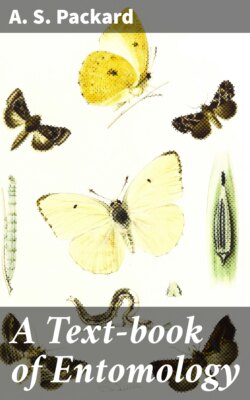Читать книгу A Text-book of Entomology - A. S. Packard - Страница 13
На сайте Литреса книга снята с продажи.
b. The integument (exoskeleton)
ОглавлениеThe skin or integument of insects consists, primarily, as in worms and all arthropods, of an epithelial layer of cells called the hypodermis. This layer secretes the cuticle, which is of varying thickness and flexibility, and is usually very dense, impermeable, and light, compared with the crust of the Crustacea, where the cuticle becomes heavy and solid by the deposition of the carbonate and phosphate of lime. This is due to the presence of a substance called by Odier chitin.[9] The cuticle is thin, delicate, and flexible between the joints; it is likewise so in such diaphanous aquatic larvæ as that of Corethra, and in the gills of aquatic insects, also in the walls of the tracheæ and of the salivary ducts. The cuticle thus forms a more or less solid crust which is broken into joints and pieces (sclerites), forming supports for the attachments of the muscles and serving to protect the soft parts within.
Chitin.—If we allow an insect to soak for a long time in acids, or boil it in liquid potassa or caustic potash, the integument is not affected. The muscles and the other soft parts are dissolved, leaving the cuticle clear and transparent. This insolubility of the cuticle is due to the presence of chitin, the insoluble residue left after such treatment. It also resists boiling in acids, in any alkalies, alcohol or ether. The chemical formula is C15H26N2O10.[10]
“Chitin forms less than one-half by weight of the integument, but it is so coherent and uniformly distributed that when isolated by chemical reagents, and even when cautiously calcined, it retains its original organized form. The color which it frequently exhibits is not due to any essential ingredient; it may be diminished or even destroyed by various bleaching processes.” (Miall and Denny.)
“The chemical stability of chitin is so remarkable that we might expect it to accumulate like the inorganic constituents of animal skeletons, and form permanent deposits. Schlossberger (Ann. d. chem. u. pharm., bd. 98) has, however, shown that it changes slowly under the action of water. Chitin kept for a year under water partially dissolved, turned into a slimy mass, and gave off a peculiar smell. This looks as if it were liable to putrefaction. The minute proportion of nitrogen in its composition may explain the complete disappearance of chitin in nature.” (Miall and Denny, The Cockroach, p. 29.)
Chitin, or a substance closely similar to it, occurs in worms and in their tubes, especially in the pharyngeal teeth of annelids and in their setæ. The shell of Lingula and the pen of cuttle-fish contain true chitin (Krukenberg). The integument of Limulus, of trilobites, and of Arachnida, as well as Myriopoda, appears to consist of chitin.[11]
The chitin is rapidly deposited at the end of embryonic life, also during the larval and pupal stages. As is well known, insects after moulting are white, but in a few hours turn dark, and those which live in total darkness are white, showing that light has a direct effect in causing the dark color of the integument.
Moseley analyzed one pound weight of Blatta, and found plenty of iron with a remarkable quantity of manganese.
Schneider regarded chitin as a hardening of the protoplasm rather than a secretion, and the cuticle is looked upon as an exudation. It is structureless, not consisting of cells, and consists of fine irregular laminæ. “A cross-section of the chitinous layer or ‘cuticle’ examined with a high power shows extremely close and fine lines perpendicular to the laminæ.” In the cockroach the free surface of the cuticle is divided into polygonal, raised spaces or areas which correspond each to a chitinous cell of the hypodermis. (Miall and Denny.)
Numerous pore-canals pass through the cuticle of all the external parts of the body. The larger canals nearly always form the way for the passage of secretions from dermal cells, or connect with the cavities of hairs or setæ; when very fine and not connected with hairs or scales, they are either empty or filled with air, and may possibly serve for respiration.
Vosseler distinguishes in the cuticle two layers of different physical and chemical characters. Besides the external chitinous layer there is an inner layer which entirely agrees with cellulose. (Zool. Centralblatt, ii, 1895, p. 117.)
The reparative nature of chitin is seen in the fact that Verhoeff finds that a wound on an adult Carabus, and presumably on other insects, is speedily closed, not merely by a clot of blood, but by a new growth of chitin.
